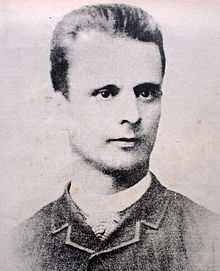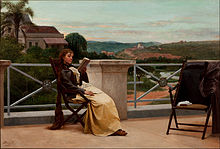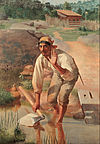
Antônio Diogo da Silva Parreiras was a Brazilian painter, designer and illustrator.

Victor Meirelles de Lima was a Brazilian painter and teacher who is best known for his works relating to his nation's culture and history. From humble origins, his talent was soon recognized, being admitted as a student at the Imperial Academy of Fine Arts. He specialized in the genre of history painting, and upon winning the Academy's Foreign Travel Award, he spent several years training in Europe. There he painted his best-known work, Primeira Missa no Brasil. Returning to Brazil, he became one of emperor Pedro II's favorite painters, joining the monarch's patronage program and aligning himself with his proposal to renew the image of Brazil through the creation of visual symbols of its history.

The Museu Nacional de Belas Artes is a national art museum located in the city of Rio de Janeiro, Brazil. The museum, officially established in 1937 by the initiative of education minister Gustavo Capanema, was inaugurated in 1938 by President Getúlio Vargas. The museum collection, on the other hand, takes its rise in the transfer of the Portuguese Court to Brazil in the early 19th century, when King John VI brought along with him part of the Portuguese Royal Collection. This art collection stayed in Brazil after the King's return to Europe and became the core collection of the National School of Fine Arts. When the museum was created in 1937, it became the heir not only the National School collection, but also of its headquarters, a 1908 eclectic style building projected by Spanish architect Adolfo Morales de los Ríos.

The creation of art in the geographic area now known as Brazil begins with the earliest records of its human habitation. The original inhabitants of the land, pre-Columbian Indigenous or Natives peoples, produced various forms of art; specific cultures like the Marajoara left sophisticated painted pottery. This area was colonized by Portugal in the 16th century and given the modern name of Brazil. Brazilian art is most commonly used as an umbrella term for art created in this region post Portuguese colonization.

Rodolfo Amoedo was a Brazilian painter, designer and decorator.

Eliseu Visconti, born Eliseo d'Angelo Visconti was an Italian-born Brazilian painter, cartoonist, and teacher. He is considered one of the very few impressionist painters of Brazil. He is considered the initiator of the art nouveau in Brazil.

The roots of Brazilian sculpture have been traced back to the late 16th century, emerging soon after the first settlements in the newly discovered land. Through the following century, most of the sculpture in Brazil was brought from Portugal and displayed Baroque features. The Baroque style would flourish within the religious culture of the country and would remain predominant until the first decades of the 19th century. In the 19th century, sculptural activity decreased, but it later revived when both the government and the public took a new interest in the art. Modernism fomented a period of intense research into a new language of sculpture, with great achievements, and the contemporary sculpture of Brazil enjoys worldwide respect.

João Zeferino da Costa was a Brazilian painter and designer.

Lucílio de Albuquerque was a Brazilian painter, designer and art professor.

Brazilian Academic art was a major art style in Brazil from the early 19th century to the early 20th century, based on European academic art and produced on official institutions of professional art education.

Events in the year 1903 in Brazil.
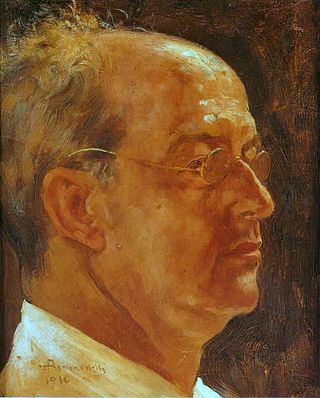
Henrique Bernardelli was a Brazilian painter.

The Imperial Academy of Fine Arts was an institution of higher learning in the arts in Rio de Janeiro, Brazil, established by King João VI. Despite facing many initial difficulties, the Academy was established and took its place at the forefront of Brazilian arts education in the second half of the nineteenth century. The Academy became the center of the diffusion of new aesthetic trends and the teaching of modern artistic techniques. It eventually became one of the principal arts institutions under the patronage of Emperor Dom Pedro II. With the Proclamation of the Republic, it became known as the National School of Fine Arts. It became extinct as an independent institution in 1931, when it was absorbed by the Federal University of Rio de Janeiro (UFRJ) and became known as the UFRJ School of Fine Arts, which still operates today.
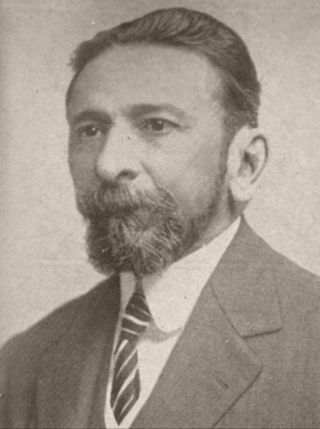
José Veríssimo Dias de Matos was a writer, educator, journalist, literary critic, and founding member of the Brazilian Academy of Letters.

Modesto Brocos y Gómez was a Spanish-Brazilian painter and engraver.

Francisco Pedro do Amaral was a Brazilian painter, designer, scenographer and gilder.

Décio Rodrigues Villares was a Brazilian painter, sculptor, caricaturist, and graphic designer. He is best known for helping to design the blue disc on the Brazilian Flag and his designs for the monument honoring Júlio de Castilhos.
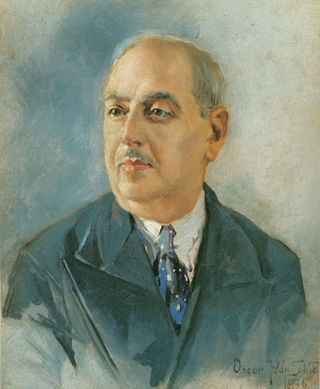
Oscar Pereira da Silva was a Brazilian painter, draftsman, designer, and instructor. He was active from the end of the 19th to the mid-20th century. He is noted for his depictions of historical events in Brazil, but also completed numerous portraits, religious works, genre scenes, still lifes, and landscapes. He "paid no attention to Brazilian folk tradition" and painted in an "antique style." After a period of study in France, he pursued a lucrative career in São Paulo, where his works are displayed at the Pinacoteca do Estado de São Paulo and the Museu do Ipiranga.
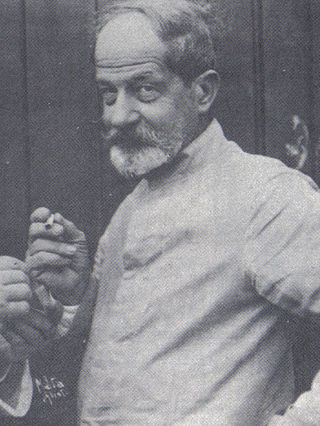
José Maria Oscar Rodolfo Bernardelli y Thierry was a Mexican-born Brazilian sculptor and art professor, of Italian ancestry.

Brazilian Romantic painting was the main expression of the plastic arts in Brazil in the second half of the 19th century. This pictorial production was part of the local evolution of the Romantic movement and approximately coincided with the period of the Second Reign, but its characteristics were unique, differing in several points in relation to the original version of European Romanticism and likewise cannot be considered an exact parallel to the manifestation of Romanticism in Brazilian literature of the same period. It had a palatial and restrained aspect, brought a strong neoclassical influence and soon blended with Realism, Symbolism and other schools, in an eclectic synthesis that prevailed until the early years of the 20th century.
